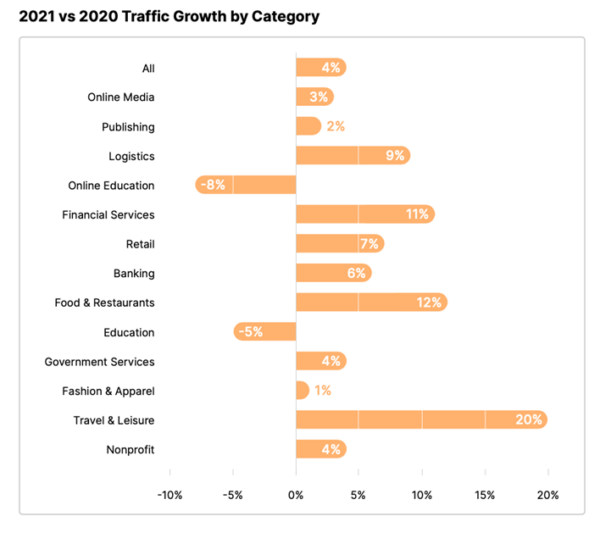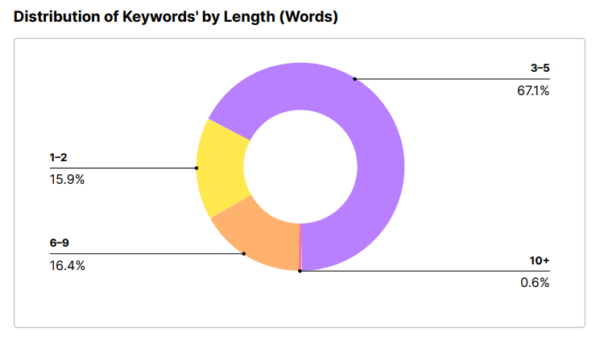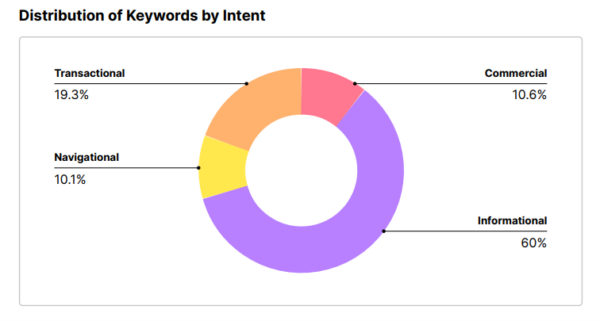The latest SEO trends can guide your content strategy. Here’s how.
A look at the latest SEO trends from Semrush’s “State of Search 2022” study reveals ways to improve your content strategy right away.

The best practices of search engine optimization are always changing, requiring marketers to change their strategy with each new update that Google makes to its algorithms.
Many of these updates can seem esoteric and untranslatable to a lay person. Thankfully, the “State of Search 2022” report from Semrush offers some insights that can inform your content strategy right away.
Let’s take a look.
Embrace these topics holistically to encourage more search traffic
As part of Semrush’s analysis of search traffic increases, the study broke down the top 100,000sites by industry and calculated search traffic by category. It found that, from 2020 to 2021, all search traffic grew by 4%. When broken down by industry, travel and leisure saw the greatest increase in search (20%), followed by food and restaurants (12%), financial services (11%) and logistics (9%). The only search categories that saw a negative trend were online education (-8%) and education (-5%).

Courtesy of Semrush
It’s worth noting that the increased search traffic for these categories aligns with the zeitgeist of 2021— while the world flirted with some return to normalcy, people were searching for travel again, interested in dining out and reassessing their finances.
While trends can offer insight into topics that may be worth folding into your content strategy, it’s important to embrace these categories holistically — any ad hoc attempt to craft content around these categories should not be disingenuous to the core function of what your content is trying to communicate. Google and other search engines evaluate rankings based on a domain’s entire site architecture, meaning that the best way to engage with trending topics is to integrate them into your entire ecosystem using a tool to determine what keywords you want to rank for.
How many keywords are effective and how long should they be?
As Semrush and other SEO tools became more popular, many marketers engaged in a practice known as “keyword stuffing”, populating their content with as many keywords as they could find. Several years ago, search engines tweaked their keyword crawlers to identify these opportunists and keep their content from floating to page 1 of search results.
The Semrush study referenced the company’s database of 160 million keywords and rankings for U.S.-based website to determine what number of keywords performed best in search. It found that the overwhelming majority (83%) of unique queries contained five words or fewer, with 3-5-word queries comprising 67.1% and 1-2- word queries making up 15.9%.

Courtesy of Semrush
The study also found that over 94% of all searches contained between one and five words, which demonstrates the popularity of what are called “short-tail keywords.” Semrush points out that short-term keywords aren’t always the best phrases to include, however—longer-tail keywords over five words are often more highly targeted to the niche topic your audience is searching for. Because of this, longer-tail keywords can be more likely to generate conversions, or actions that searchers take on your site such as signing up for a consultation, buying a product, etc.
Why your keywords should answer a question
Semrush also points out that 60% of unique search terms seek an answer a specific question or query, what SEO wonks call “informational intent.”

Courtesy of Semrush
“Informational queries, e.g. ‘coffee calories,’ tend to be more nuanced than most, in that the same topic or search intent can be phrased in a number of different ways to trigger specific results,” write the study’s authors. “Commercial and transactional queries tend to rely on other factors without the extra details you might find in informational queries. For example, a parent may search for ‘pants for kids,’ but may be less likely to search for ‘blue pants for an average height 10-year-old.’
“By contrast, most informational pages don’t have the filters you might find on, say, an apparel store’s product category pages, so the user needs to be much more specific with often lengthier queries and more unique keywords. The sheer number of informational keywords becomes clearer when you put the intent categories into the context of market share.”
To recap: think about how your content can include phrases from one to five words, the shorter the better — and do what you can to ensure that the search phrase points to a specific question or need that your content offers a solution to.
Check out more SEO trends in Semrush’s “State of Search 2022” report.







